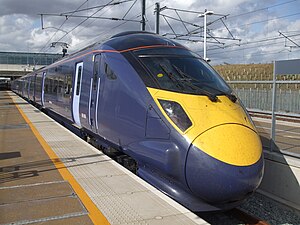British Rail Class 395
| British Rail Class 395 | |
|---|---|

395008 at Ebbsfleet International in 2009
|
|

The interior of a Class 395 MSO vehicle
|
|
| In service | 29 June 2009 – present |
| Manufacturer | Hitachi |
| Built at | Kasado factory, Yamaguchi, Japan |
| Family name | A Train |
| Number built | 29 trainsets |
| Formation | 6 cars per trainset DPT1+MS1+MS2+MS3+MS4+DPT2 |
| Fleet numbers | 395001–395029 |
| Capacity | 340 seats + 12 tip up |
| Operator(s) | Southeastern |
| Specifications | |
| Car body construction | Aluminium |
| Train length | 121.3 m (398 ft 0 in) |
| Car length |
PDTSO - 20.88 m (68 ft 6 in) MS - 20.00 m (65 ft 7 in) |
| Width | 2.81 m (9 ft 2 5⁄8 in) |
| Height | 3.817 m (12 ft 6 1⁄4 in) |
| Floor height | 1.235 m (48.62 in) |
| Wheelbase | 2.6 m (102.36 in) (bogies) |
| Maximum speed |
AC service: 140 mph (225 km/h) DC service: 100 mph (160 km/h) Record: 157 mph (253 km/h) |
| Weight | 265 t (261 long tons; 292 short tons) (empty) |
| Traction system | EMU |
| Traction motors | 16 x 210 kW (280 hp) |
| Power output | (?) |
| Transmission | Electric transmission |
| Acceleration | 0.70 m/s2 (2.3 ft/s2) |
| Deceleration | 0.90 m/s2 (3.0 ft/s2) 1.20 m/s2 (3.9 ft/s2) (emergency) |
| Auxiliaries | 3 x 110 kW (150 hp) 3-phase AC + 110 V DC) |
| Power supply | (?) |
| Train heating | (?) |
| Electric system(s) |
25 kV 50 Hz AC overhead lines, 750 V DC third rail |
| Current collection method |
Pantograph (AC) Contact shoe (DC) |
| UIC classification | 2'2'-Bo'Bo'-Bo'Bo'-Bo'Bo'-Bo'Bo'-2'2' |
| Bogies | (?) |
| Braking system(s) | electropneumatic |
| Safety system(s) | TVM430, AWS, TPWS, KVB |
| Track gauge | 1,435 mm (4 ft 8 1⁄2 in) standard gauge |
| Notes | |
| Sources: except where noted | |
PDTSO - 20.88 m (68 ft 6 in)
The Class 395 "Javelin" is a dual-voltage electric multiple unit (EMU) built for high-speed commuter services on High Speed 1 and elsewhere on the Integrated Kent Franchise.
The 6-car trains were built in Japan by Hitachi and operate at a maximum speed of 140 mph (225 km/h) under 25kV AC overhead electrification on High Speed 1, and 100 mph (161 km/h) on 750 V DC third rail supply on conventional lines.
The use of the high-speed trains as part of the transport infrastructure for the Olympic Park formed part of the original bid for the 2012 Summer Olympics. The service was named the Olympic Javelin Shuttle, and was the origin for the nickname "Javelin". The Olympic services began 28 July 2012.
In December 2003, formal approval was given to run domestic services on the planned Channel Tunnel Rail Link (CTRL, now known as High Speed 1, or HS1) in Kent, England, Preliminary consultations for a new franchise including then CTRL, and for rolling stock to operate the 'CTRL Domestic' services were to begin in 2004. In 2005 the proposed high-speed services were combined with those from the former South Eastern rail franchise to form the Integrated Kent franchise (IKF).
In October 2004, Hitachi was announced as the preferred bidder to supply high-speed trains for the CTRL services, and in June 2005 the £250 million contract was signed with Hitachi Europe Ltd as supplier of 28 trainsets, with HSBC Rail acting as the financier (), and with an expected service date of 2009. In November 2005 the Department for Transport announced Govia as the new operator of the IKF.
The contract was Hitachi's first rail vehicle sold to a UK or European customer. It had previously worked with HSBC Rail and UK rail authorities between 2002 and 2003 to demonstrate the suitability and conformance of Hitachi's traction system with the UK rail network, including test of the use of AC induction motors, and Electromagnetic compatibility tests.
...
Wikipedia
